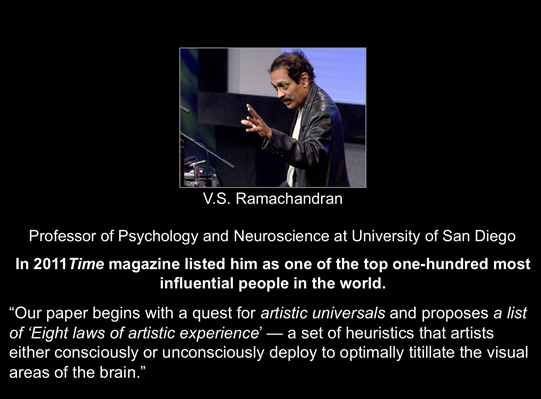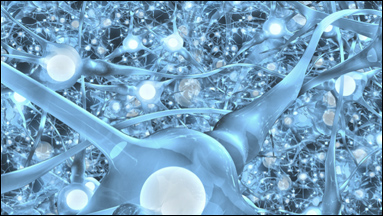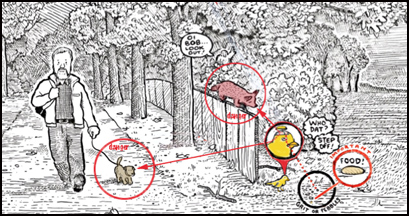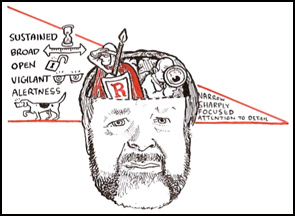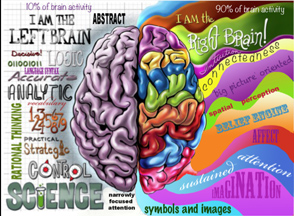 |
||||||||||||||
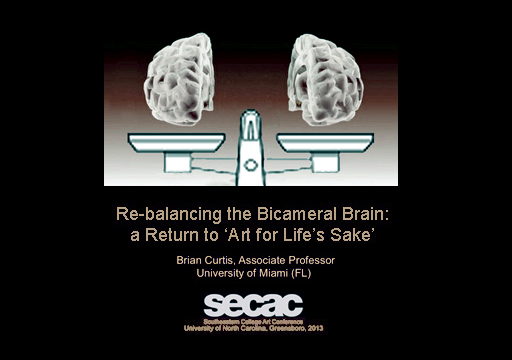 |
||||||||||||||
| Paper delivered by Brian Curtis, Associate Professor, University of Miami, Coral Gables, Florida at the SECAC Conference in Greensboro, NC, October 31, 2013 for a panel titled Perception Point: The Intersection of Neuroscience and Contemporary Art, Chair, Ann Pegelow Kaplan, Elon University | ||||||||||||||
|
I am here to talk about the interrelationship of art, science, and the human brain. I have great respect for both art and science and it is in that spirit that I intend to demonstrate that the art/science intersection known as Neuroaesthetics is based on a seriously sophomoric understanding of art and on surprisingly clumsy science. On the positive side, I will introduce information about the complex functionality of the bi-cameral brain that provides a far more effective entry point for developing valuable insights into the nature and experience of art. I am a studio artist with no formal education in science. I do, however, come to this subject with reasonable intelligence and common sense and thirty years of experience as an artist. I am here to challenge Neuroaesthetics because I see this questionable branch of neuroscience as the latest manifestation in a one-hundred-year progression of disruptive theoretical models that have all but denuded the cultural habitat that once supported life-affirming, sensory-based aesthetic traditions. In place of time-honored traditions we now find a jumble of second-hand interpretations of arcane modern and postmodern intellectual perspectives that celebrate a world-view whose disembodied, de-contextualized characteristics more closely resemble symptoms of mental illness than the underpinnings of a cultural model capable of supporting a commitment to ‘art for life’s sake’.
Without such a definition there is no basis for interpreting localized increases in blood flow from fMRI scans as an explanation of how humans respond to art.(5) Neuroaesthetics further undercuts any claim of credibility by failing to acknowledge the insurmountable barriers created by the bewildering anatomical complexity of the human brain.
A typical healthy brain houses between 100 and 200 billion neurons connected by hundreds of trillions of synapses and that each synapse, by itself, is more like a microprocessor–with both memory-storage and information-processing elements–than a mere on/off switch. In fact, one synapse may contain on the order of 1,000 molecular-scale switches.(6) That means there are over a hundred thousand trillion switches (one quadrillion). “Even further complicating this picture is that these connections occur in many different ways, including different placements on neurons, as well as connections with the larger number of other brain cells that aren’t neurons. Complex neurons often have ten different processes going on simultaneously including position-based and time-based reactions, variations in general signal strengths and background noise, distributed excitation and inhibition, and many chemical factors based on the neuron’s multiple channels. To make matters worse, from the same input two individual neurons can fire differently leaving the final decisions to a democratic vote of different neurons further down the circuit. Many of these connections change every day. Currently, we don’t have computers powerful enough to compute a map of a cubic millimeter of birdbrain, even if we knew what the connections were.”(7) A recent comparison between the sixteen-year project of mapping the human genome and the proposed mapping of the human brain suggests that mapping the brain will be one million times more complicated. Most projections call for it to take one-hundred years. And philosopher David Chalmers has categorized this sorting out of the details of the brain’s anatomical complexity as the ‘easy’ problem. ‘Easy’, that is, as in curing cancer or launching a manned flight to Mars.(8) The ‘Hard Problem’ is understanding how human consciousness emerges from biological, chemical, and electrical processes. And perhaps most humbling in this daunting investigation is that any of the inroads that might be made into the ‘Easy Problem’ are considered highly unlikely to bring a solution to the ‘Hard Problem’ any closer. Keep in mind that there is considerable controversy about whether seeking the mechanisms of consciousness is even an appropriate question for science to ask. Philosopher Colin McGinn goes so far to suggest that our brain might be evolutionarily unequipped “to intuitively grasp why neural information processing observed from the outside should give rise to subjective experience on the inside.”(9) And the problems facing Neuroaesthetic research get more complicated. Neuroaesthetics’ underlying scientific model is stuck in a time warp. Its biology is mired in the materialism of Newtonian mechanics even though it has been known for over a century that Newton’s laws don’t apply to either micro or macro worlds. Cognition researcher Piero Scaruffi speculates on a more up to date approach. “Loosely speaking, the point is that consciousness is unlikely to arise from classical properties of matter (the more we understand the structure and the fabric of the brain, the less we understand how consciousness can occur at all). But Quantum Theory allows for a new concept of matter altogether, which may well leave cracks for consciousness, for something that is not purely material or purely extra-material.”(10) Fortunately, there is an alternate way to attend to the brain that provides meaningful insights into embodied human experience. It begins with an acknowledgement of the profound division of the brain into two lateral hemispheres each of which produces radically contrasting approaches for engaging the world. It is theorized that these differences stem from an evolutionary necessity to provide two contrasting ways of connecting with the world – two types of attention functioning simultaneously – presenting two individually coherent but stylistically incompatible ways of interacting with the world. One brain with two halves – each with distinct sets of sensations, values, and personality. One, the left hemisphere, that provides narrowly focused, decontextualized, objective, detail oriented attention and one, the right hemisphere, that provides broad, open, alert, sustained, vigilant attention.(11)
These hemispheric differences, which have long informed mythology and folk traditions were embraced by science in the 1950’s after studying patients who underwent the severing of the neuronal bridge connecting the two hemispheres. Experiments on these split-brain patients displayed the lateralized styles of attention mentioned above. The meaningfulness of the differentiation was seriously downplayed in the 1980’s when scientists misinterpreted data from electro-encephalograms that showed the entire brain to be actively involved throughout all mental processes. When interpreting this data scientists concluded that there were no substantive differences in functioning between the hemispheres. While they were quite correct in assuming that the whole brain is involved in every brain function it turns out that they were wrong in denying substantive differences in functioning. The important difference in functioning is not what either side of the brain does, it is how it does it.
Since the 80’s additional research has been conducted on patients with brain lesions, stroke victims, on subjects with temporarily deactivated hemispheres (anaesthetized), and normal subjects in controlled situations where their brains are exposed one hemisphere at a time to sensory stimuli. The data from these follow-up populations consistently supports the fact that right-brain emphasizes feeling (empathy) in decision making, thinks in images, its where we interpret emotional content in communication, its where free association takes place, its where facial expression is interpreted, its where humor and metaphor (i.e. implicit meaning) are rooted, its where spiritual experience, spatial perception peripheral vision, and color perception are monitored. The right brain feels comfortable taking risks and entertaining thoughts of mortality (melancholy). It responds to melody, tone, timbre, harmony, and aural complexity. Recently, however, neuroanatomical research has found that many of these connecting neurons perform inhibitory functions thereby slowing down the exchange of information. The inhibitory process is currently presumed to be a way to preserve the integrity of each hemisphere’s style of processing thereby preventing the confusion that might arise from two conflicting modes of attention. The implications of hemispheric brain differentiation were recently addressed by Iain McGilchrist, a former poetry professor at Oxford and now a practicing psychiatrist and professor of Psychiatry at Oxford. His remarkably engaging and innovative book, The Master and His Emissary, analyzes the characteristics of cultures throughout the span of Western civilization from the pre-Socratic 6th century Greece up through the Postmodern period in terms of whether they have stylistically attended to the world at large in a hemispherically balanced or imbalanced fashion. He does so with an encyclopedic and insightful survey of neuroanatomy, neuropathology, psychology, philosophy, religion, history, music, and art. His analysis of culture is based on his hypothesis that a society shaped by excessive dependence on a single hemisphere would exhibit behavioral shortcomings and restricted functionality similar to those exhibited by individuals with severe brain damage. McGilchrist begins his investigation with the observation that, even though language dominates our conscious idea of self, no less than 90% of our brain activity is non-verbal. This means that despite the tendency of language to dominate our self-reflective consciousness, the ‘I” inside the head, it is right-brain processing, intuition, that makes up the majority of who we are. He points out that empathy and context ground our sense of self and of everything that lies outside of ourselves. It is this preconscious awareness that provides ‘primary consciousness’ of being.(12) Even though perception is primary we rely on our left-brain’s ability to reprocess our perceptions so that we can ‘know’ them. These rational processes are virtual, fragmented, decontextualized re-presentations of our direct engagement with the phenomenal world. The focused, abstracted, detached attention of the left-brain contributes a valuable and necessary distance from the phenomenal world and it provides complementary functionality to the broad, sustained, alert, flexible, contextual right brain attention. To be a fully integrated, satisfied, and creative human being we need to integrate both hemispheric strategies in everything we do. Imbalance damages our integrity. These hemispheric brain differences are substantive and our acknowledgement of how they complement one another profoundly affects how we understand the complexity of subjective consciousness. The type of attention we apply to the world changes what we find and what we find in turn changes us – a reciprocal process. How we choose to attend to the world has considerable consequence. In McGilchrist’s analysis of Western civilization he only identifies six cultural periods as reflecting traits of balanced attention while the majority of cultures appear pathologically dependent on modes of attention associated with the left-brain. In pathologically unbalanced cultures he predicts the conceptualization of the four primary sources of intuitive satisfaction. Nature is despoiled by a world view that sees it only as a commodity to be consumed, the spiritual impulse is dismissed out of hand or deprived of mystery by an overreliance on rules and dogma, the body is devitalized, objectified and decontextualized, and art falls victim to an avalanche of hyper-rationality that deprives it of empathy and renders it ineffective as the bridge between the self and that which exists beyond, outside the self. Applying the hemispheric differentiation model to contemporary Western culture results, most would agree, in a finding of severe and increasing imbalance toward the left hemisphere. Such a finding goes a long way in explaining why science feels free to overstep its bounds as it clumsily attempts to displace subjective relational experience with abstract, fragmented data. It is our responsibility as artists and art historians, as keepers of the flame of empathetic engagement with the world, not to allow ourselves to default back to a mechanistic model of virtual, fragmented, decontextualized re-presentations of consciousness when what promises far greater insight and satisfaction is a fluid, open, infinitely complex, ever changing, endlessly interrelated, relational model capable of shedding light on the fullness in which our brain engages with itself and with all that is outside itself. It is time for a return to 'art for life's sake'.(1) Dutton, Denis, The Art Instinct, |
||||||||||||||
| PRESENTATION INDEX | SITE INDEX | |||||||||||||
| email: brian_curtis@mac.com | ||||||||||||||
| University of Miami Faculty Webpage | ||||||||||||||
| last updated 07/25/2016 | ||||||||||||||


